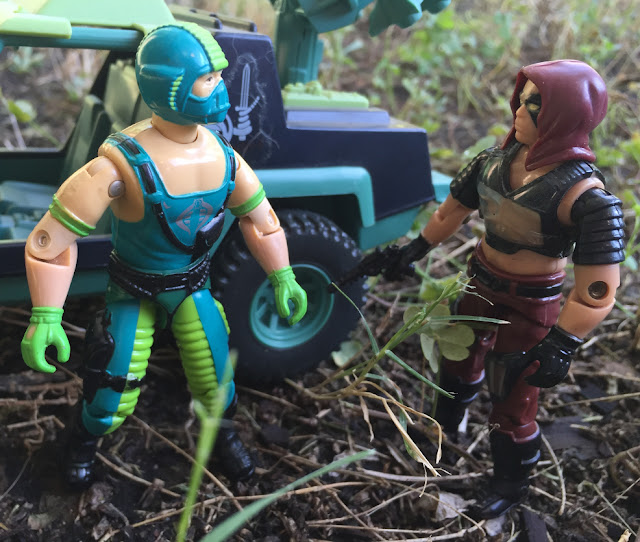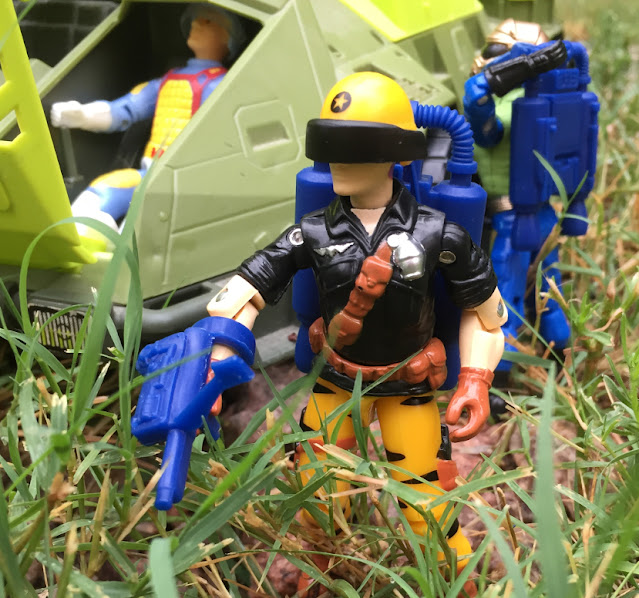In early 1984, I found my first three new G.I. Joe figures of the year. I bought myself
Firefly because even back then Firefly was awesome. My youngest brother got the
Baroness. And, my younger brother got
Roadblock. Roadblock was an amazing figure at the time. And, while he was somewhat engulfed by the sea of awesomeness that was the 1984 series, he stood apart as something that blended with the prior years of figures while also bringing something new to the Joe line. He was introduced with Duke in the comic book and quickly became a major player. In time, though, my Roadblock's accessories broke and he became less and less a part of my daily play routine. As I got older, limitations of the mold started to be more obvious. But, as a nostalgic favorite, Roadblock held up pretty well.
Due to his oversized personality in both the comics and cartoon, Roadblock became a fan favorite. When it came time for G.I. Joe to return to retail in 1997, Hasbro showcased a repainted 1984 Roadblock as one of the proposed Joe figures. But, 1997 came and went with no Roadblock appearance. The 1986 Roadblock body appeared on other characters. But, Roadblock was a no show. The same was true in 1998. Then, when Joe returned to retail in 2000, Roadblock was again absent. By then, we'd seen two Fireflies, multiple releases of the Baroness mold and even some new characters without a Roadblock. In mid 2001, the version 1 Roadblock mold finally returned to retail. It came, though, with a twist. Roadblock was gone and the iconic figure was rebranded as Double Blast.
The reasoning behind Double Blast was copyright loss. At least, that was the story. Double Blast featured a file name for a prominent G.I. Joe collector of the era who was well connected with the folks in Hasbro who also created Sure Fire and Big Brawler. In 2002, though, the Roadblock name was back, though that figure also featured the collector homage file name. And, it was not until 2003 that Roadblock with the Marvin F. Hinton name returned. The issue, though, was that this homage figure did not feature a new head. So, it became rather difficult to use both Roadblock and Double Blast together. So, the notion of Double Blast died out as collectors adopted this figure as just another Roadblock repaint.
Double Blast uses the exact mold of the 1984 Roadblock. So, the lack of size from the original figure carries over. And, for a man who is supposed to be massive, this Roadblock is rather scrawny. But, as a kid, you didn't worry about such things. And, my entire view of the original Roadblock mold is shaped by the opinions of it that I forged as a ten year old. The figure's arms, though, would become the bane of early 2000's Joe collectors as Hasbro reused them on, seemingly, every single figure they could. But, in 2001, it was nice to see the full figure return to retail. He looked a bit out of place among the figures with larger physiques who were later releases. But, the mold's strength is tied to its release year and Double Blast fits in well with all Joes made of 1984 and earlier molds.
Double Blast's gear, ostensibly, is the same as Roadblocks. You get the Browning .50 cal machine gun, but in black. Subsequent to 2001, this weapon would become ubiquitous. But, this was the first appearance in this dark color. You get the tripod on which Double Blast can mount the weapon. A facsimile of Roadblock's original helmet is included. With it, the massive cranium of the Roadblock figure is less of an issue. (As far as I can remember, too, this was the final appearance of any helmet based on the original 1982 design.) Roadblock's backpack is included. Now in an olive green color, the backpack mold was modified. First, the peg on which the tripod was hung for easy storage is gone. No longer can Roadblock realistically carry all his gear. The second change is that the ammo pack that was removable from the bottom of the pack has been either glued or fused into place. So, the pack is now a single piece. This isn't a huge deal as the ammo pack didn't really work and was a fairly obscure feature of early Joe figures.
The figure's colors, though, are drab and boring. The original Roadblock featured green and brown, but it was more dramatic and pleasing to the eye. Double Blast used the dark, drab olive and browns that were all too common in the A Real American Hero Collection figures from
2000 and 2001. So, the figure disappeared in a sea of sameness of the retail offerings of that era. Now, it's less problematic. But, given a choice, I'm going to pick the original Roadblock over this figure every time. The only upside to this figure is the softer plastic which makes broken thumbs and crotches far less common. But, it also allows the hands to stretch out and not hold weapons all that effectively. Double Blast also features the marbelized plastic for the legs. As such, no two Double Blasts will be identical and you'll find different mixes of colors on different figures. That's, probably, the only thing really interesting about this figure.
And, that leads to the fact that there's really no purpose for this figure. Roadblock is a better character. The vintage Roadblocks are fairly available and are far superior to Double Blast. Due to the similarities, you can't use the two characters together. You could take a 1986 or
1992 Roadblock mold derivative and use it in companion with Double Blast. But, why? Rock and Roll is a better companion and far more interesting character. There's no reason for this character to exist. But, I have to admit that it was better to get this version of the original Roadblock mold with all his gear and the wrong code name than not getting him at all. (The same is not true of the other homage figures.) At, in 2001, original Roadblocks were somewhat pricey. So, collectors of the era were offered a cheap alternative to a mandatory figure in everyone's collection.
Wave III of the A Real American Hero Collection, of which Double Blast is a part, didn't ship for long. It debuted in the summer of 2001: right as retailers were mightily struggling with massive pegwarmers from Wave II. (Mostly
Big Ben and Whiteout. But, even the
Rock Viper/
Major Bludd pack was available everywhere.) Wave IV would end up at discount, close out and bargain bin retailers. But, Wave III did not. While few collectors missed it at retail, the actual release window was short. Fortunately, the dominant army builder of the wave, the
Laser Viper, was carried over into Wave IV. (The
Fast Blast Viper was seen as a specialty Viper by collectors of the time and few people bothered with more than a couple of them.) But, as Wave IV shipped so quickly after Wave III, the Double Blast wave never really had time to permeate the Joe ethos of the era. The members of the wave were quickly forgotten and you rarely saw them in photos or dio stories of the day.
I saw this figure as a Roadblock hack job. And, as Roadblock had been a childhood favorite, I had no use for Double Blast. Looking back at photos of the time, he rarely appears. And, I was always trying to find ways to incorporate new releases into photos during that time frame. All of the Wave III Joes, though, are relatively scarce. The wave never resonated with me as the figures were barely rehashes of the vintage figures. Had Double Blast adopted something like a
Sky Patrol or
Eco Warriors motif, he would have at least been interesting. But, Hasbro was falsely lead to believe that collectors only wanted "realistic military" at the time. And, that was a big reason why the A Real American Hero Collection ultimately failed and was replaced by the
JvC era which brought back a far greater panoply of colors and re-invigorated G.I. Joe at retail.
It is my perception that this Roadblock was done to death. But, truthfully, it saw two vintage uses: in
1984 and in
1988 for the
Tiger Force version. Double Blast debuted in 2001. The character was then finally changed to Roadblock in the 2002 BJ's Gift set. He appeared again in the
2004 Night Force set. After that, Hasbro got the
1992 Roadblock mold back from
Funskool and used it for the character with a break in
2005 when the body was used for a terrible Comic Pack figure that featured a new head. That doesn't seem like much. But, both the BJ's Roadblock and the
Night Force Roadblock have alternate,
unproduced variations. On top of that, Roadblock parts were cannibalized for many other figures including the 2001
Leatherneck, 2004
Flint and even the
2006 Tommy Arashikage. The arms appeared on too many figures for me to bother to look up. All of these uses in a short time oversaturated the mold and it lost much of its vintage luster. But, if you want a good Roadblock, this is about your only non-vintage option as all subsequent releases were missing gear and had limiting paint jobs.
In the weird G.I. Joe world of 2020, carded Double Blast and Crossfire packages sell for about $15. Yet, at the same time, dealers sell a metric butt-load of mint and complete with filecard Double Blasts for the same price. Left to the open market, he's about an $8 figure. So, you're far better off buying and opening up a carded sample to get the figure. (Crossfire sucks. Don't let anyone tell you otherwise. He's one of the worst releases of the repaint era.) As a Roadblock clone, this figure is relatively worthless. But, as a new version of Roadblock done in softer plastic, it works perfectly. And, the price isn't too high where the figure no longer makes sense. Double Blast is definitely a release that, were I not collecting and buying Joes at retail during his release window, I would not own. He's not interesting enough to track down for anything other than completion. But, boring figures can still be nice figures and I do find this version of Double Blast useful to have around for background filler and other mundane uses.




































